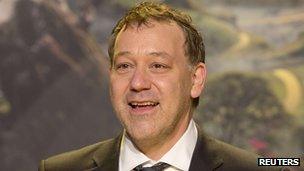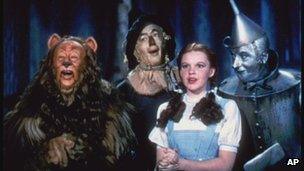Sam Raimi re-builds Oz for a 3D audience
- Published
James Franco and Zach Braff speak to Georgie Rogers about their roles in the film
L Frank Baum's children classic The Wonderful Wizard of Oz has inspired countless adaptations since it was written in 1900.
As well as the Oscar-winning 1939 film, starring Judy Garland, there has been The Wiz - the Motown-produced version starring Diana Ross and Michael Jackson - unofficial Disney sequel Return to Oz and even a Muppet version.
On stage, the tale has also undergone many incarnations, including the recent Andrew Lloyd Webber West End production and the Tony award-winning musical Wicked - told from the perspective of the witches - which continues to be a hit both in London and on Broadway.
For his new take on the tale, director Sam Raimi's plan from the outset was to make a film that serves as a prequel to Baum's book.
His 3D version, Oz The Great And Powerful, tells the untold story of how a charming con-man, Oscar Diggs, became the wizard of Oz.

Oscar Diggs (James Franco) arrives in the land of Oz to be greeted by Theodora (Mila Kunis)
"Thank God we weren't trying to remake the sacred classic that everybody loves," says Zach Braff, who plays both Diggs' underappreciated circus assistant and provides the voice of a computer generated flying monkey.
"Audiences really like that world, so with all this amazing technology today... it made sense to tell an origin story of 'how did this guy end up behind the curtain?'" he explains.
The film stars 127 Hours actor James Franco as Diggs, a con-man who finds himself in Oz after being caught up in a Baum-esque freak tornado.
He is greeted, in turn, by warring witch sisters Theodora, Evanora and Glinda, played by Mila Kunis, Rachel Weisz and Michelle Williams respectively, who show him the good and the bad in the mystical land.
Academy Award-winner Weisz says the chance to play a "good old-fashioned villainess" drew her to the role of Evanora.
"I thought it would be really fun to play someone really bad and evil... the more evil they are, the more fun they have." she says.
The actress remembers going to see the 1939 MGM film as one of her first trips to the cinema.
"What makes that film very charming, is the sweetness," she says. "You can see the make-up and the special effects are at the beginning of what special effects can do."

Michelle Williams, Rachel Weisz and Mila Kunis star as three witches in the film
"The fact that now they can make me look like I'm flying, when I'm on wires, is impressive."
Despite the technological advancements, Franco says there were certain elements of the book and Judy Garland film that were imperative for this version of Oz to be believable.
"You need the yellow brick road, the Emerald City; you expect flying monkeys, munchkins, witches, wizards - you need all those things for it to be Oz," he says.
"But then you also need a fresh take on it, and one of the things that they can do - 70 years later - is create the land of Oz in a seamless and spectacular way.
"They don't need to rely on theatrical conventions anymore and they don't need grown men in lion pyjamas. They can make creatures that look like an actual flying monkey, and you believe it."
Raimi's new Disney offering cost approximately $200m (£133m). Money well spent, argues Braff.
"What Sam did with 3D, and what [production designer] Robert Stromberg did with the look of the thing, is really a whole other level of what you can do these days."
The sets, masterminded and built by Stromberg - who also worked on Disney's recent remake of Alice in Wonderland - were a key feature of Raimi's vision of Oz.

Oz The Great & Powerful marks director Sam Raimi's first film since 2009's Drag Me To Hell
The director himself was very involved in controlling the look and feel of the film, down to the smallest detail.
"You build everything - from the smallest blade of grass to the smallest blossom, to the insects and squirrels, to the trees," explains Raimi.
"Then there were cities and lands and forests," he continues.
"Glinda's kingdom had to look French Nouveau, very feminine to reflect her character; the Emerald City had to be the Manhattan of Oz - sophisticated, art deco, sharp angles and very strong contrasts."
As for making the film in 3D, Raimi says he and his team "went to school" to study the format and "learned how it was best done from the ground up".
He used several techniques, including editing in longer takes and using a lot of light to give the feeling that "the air of Oz would seem like it was crystal clear, so you could see forever".
"These things, and more, were designed to pull the audience into the experience and give them perhaps the best 3D they've ever seen," the director says.
"If people are conscientious and they want to learn how to do it, it can be done very well now."

Judy Garland with the Cowardly Lion, the Scarecrow and the Tin Man in 1939 The Wizard of Oz film
Reviews for the film in the US have been mixed. The Hollywood Reporter, external claims the "unimaginative" film is pitched at children under the age of six, but others reviewers praise the colourful "feast for the eyes", external and immersive 3D experience.
However, Raimi believes he achieved a film which "fits right into the Disney mould of family entertainment" - but one that does not claim to be in the same league as the 1939 film.
"The Wizard of Oz is such a spectacular picture and holds such a dear place in my heart that I would never want to claim that we captured any of that very special magic," he says.
"But this picture is a unique thing and I think that is has its own level of magic."
Oz The Great & Powerful is out on general release.
- Published11 November 2012
- Published4 October 2012